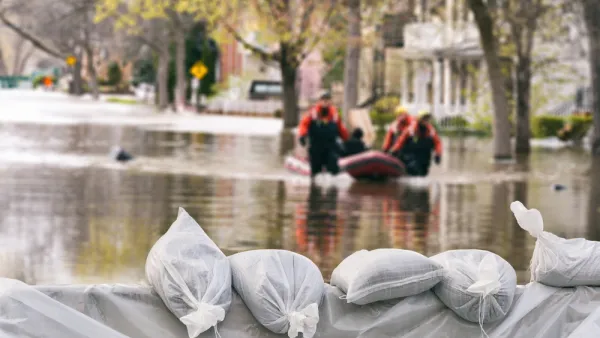As weather events become more intense and unpredictable, transit agencies must take steps to protect their aging infrastructure from flooding, storms, and extreme heat.

Writing in Next City, Whitney Bauck outlines some solutions for protecting public transit systems from extreme weather and other climate-related problems. “Transportation is responsible for 27% of U.S. carbon pollution, and public transit is a key tool for bringing those emissions down,” writes Bauck. “If train and bus service is disrupted by extreme weather, people may turn to more emissions-intensive ways of getting around, creating a negative feedback loop that fuels the global temperature rise that caused the disruptions in the first place.”
Bauck quotes Yonah Freemark, senior research associate at the Urban Institute, who says that one key factor is structural improvements: pointing to the flooding that has occured in New York City’s subway system, Freemark says “it’s crucial to address any potential entry points where water can get into the system, whether from sea water, as New York City saw in the case of Hurricane Sandy, or from excessive rain, as in the case of Hurricane Ida.” Alex Engel, senior communications manager at NACTO, adds that bus systems are also vulnerable to weather events, saying “climate adaptation needs to include the construction of high-quality bus shelters that shield riders from the elements in extreme heat and storms if they want passengers to keep using the bus system.”
In addition to transit infrastructure itself, preserving access to transit also means maintaining the routes that people use to get to and from transit stops. “When sidewalks are poorly paved, curb ramps are deprioritized and bike lanes aren’t protected, riders who need public transit the most — the vision-impaired, wheelchair users, or anyone who lives far from the places they need to go — may be unable to get to and from public transit stations safely.” Bauck highlights the benefits of greening cities with projects such as bioswales, trees, and landscaping that mitigate the effects of extreme heat and flooding and reduce air and water pollution, improvements that can help make and keep transit systems safe, efficient, and comfortable for riders.
FULL STORY: Extreme Weather Is Only Getting Worse. Can Cities Protect Public Transit?

National Parks Layoffs Will Cause Communities to Lose Billions
Thousands of essential park workers were laid off this week, just before the busy spring break season.

Retro-silient?: America’s First “Eco-burb,” The Woodlands Turns 50
A master-planned community north of Houston offers lessons on green infrastructure and resilient design, but falls short of its founder’s lofty affordability and walkability goals.

Delivering for America Plan Will Downgrade Mail Service in at Least 49.5 Percent of Zip Codes
Republican and Democrat lawmakers criticize the plan for its disproportionate negative impact on rural communities.

Test News Post 1
This is a summary

Test News Headline 46
Test for the image on the front page.

Balancing Bombs and Butterflies: How the National Guard Protects a Rare Species
The National Guard at Fort Indiantown Gap uses GIS technology and land management strategies to balance military training with conservation efforts, ensuring the survival of the rare eastern regal fritillary butterfly.
Urban Design for Planners 1: Software Tools
This six-course series explores essential urban design concepts using open source software and equips planners with the tools they need to participate fully in the urban design process.
Planning for Universal Design
Learn the tools for implementing Universal Design in planning regulations.
EMC Planning Group, Inc.
Planetizen
Planetizen
Mpact (formerly Rail~Volution)
Great Falls Development Authority, Inc.
HUDs Office of Policy Development and Research
NYU Wagner Graduate School of Public Service





























